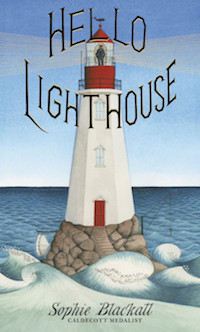Hello Lighthouse facts for kids
 |
|
| Author | Sophie Blackall |
|---|---|
| Publisher | Little, Brown, and Company |
|
Publication date
|
April 10, 2018 |
| Pages | 48 |
| Awards | Caldecott Medal |
| ISBN | 9780316362382 |
| OCLC | 978712587 |
Hello Lighthouse is a beautiful picture book created by Sophie Blackall. She wrote the story and drew all the pictures. The book shares the tale of a lighthouse and the person who was its last keeper. It was very popular and won the 2019 Caldecott Medal for its amazing illustrations. Sophie Blackall got ideas from many places and worked hard on every part of the book's design. The words and pictures work together to show how the sea changes and stays the same.
Contents
How the Book Was Made
In 2013, Sophie Blackall found an old picture at a flea market. It showed a lighthouse at the very top of Newfoundland, an island in Canada. This picture stuck in her mind. Even though she was busy with another book, Finding Winnie, this image later inspired Hello Lighthouse.
Getting Ideas for the Story
When writing the story, Blackall wanted to show more than just the brave actions of lighthouse keepers. She also wanted to highlight how their wives were "equally brave." She found inspiration in two of her favorite books, Ox-Cart Man and The Little House. These books also show how time passes.
Blackall knew early on that she would switch between scenes inside the lighthouse and scenes outside. She carefully designed the book with her editor. Reviewers later praised this detailed effort. Blackall wrote the book after a difficult time in 2016. She said it was a "great comfort" to paint and imagine herself on a tiny island at sea.
The book was officially published on April 10, 2018.
What Happens in the Story
The book begins by describing the lighthouse. It stands "On the highest rock of a tiny island at the edge of the world." The story says, "It is built to last forever."
A new lighthouse keeper arrives at this special place. He makes the lighthouse his home and starts writing in its logbook. As the keeper writes in the log, he lives his life. He gets married, helps people from a shipwreck, gets sick, and welcomes a child.
While these events happen, the book also describes the ocean. The phrase "Hello! ...Hello! ....Hello!" is repeated often. At the end of the story, the lighthouse becomes automated. This means machines take over the keeper's job. The keeper and his family move to a small house on the mainland. From there, they can still see the lighthouse, which continues to shine brightly.
Pictures and Main Ideas
Sophie Blackall used Chinese ink and watercolor to create the illustrations. The pictures are bright and full of details. They look a bit old-fashioned, which gives them a unique and special feel. This art style fits well with the story's nostalgic tone. The simple words in the book remind you of the keeper's logbook. The book's tall, narrow shape also looks like a lighthouse itself.
Repeating Patterns and Themes
The story's repeated phrases and steady pace help show the characters' daily routines. Reviewers noticed how the book shows both constant things and changes. The lighthouse stays the same, even appearing in the same spot on different pages. But the keeper's life changes, and the sea goes through different phases. The ocean is always in the background, even when the story focuses on special moments for the lighthouse family. Circles are also a repeated shape in the illustrations. Instead of being a sad look back at the past, the book celebrates those times.

